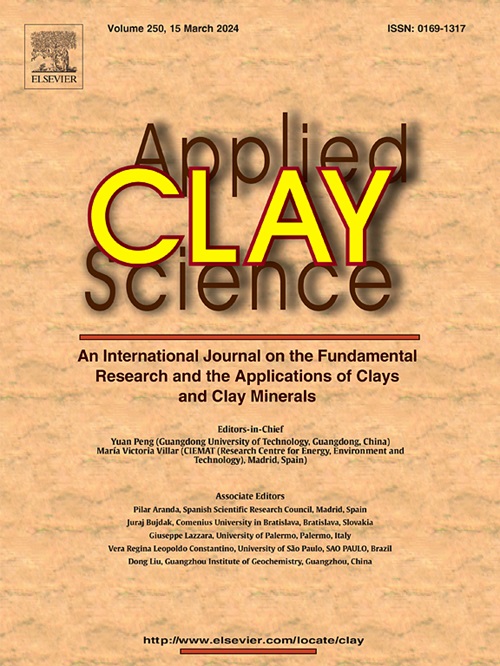高性能锂离子电池用高岭土调制MoC-MoN异质结
IF 5.3
2区 地球科学
Q2 CHEMISTRY, PHYSICAL
引用次数: 0
摘要
过渡金属碳化物-氮化物异质结在锂离子电池中因克服了多硫化物溶解、阴极电导率差和电极反应动力学缓慢等问题而受到广泛关注。然而,精确地设计和合成这些潜在的重要材料仍然具有挑战性。本文提出了一种利用高岭土进行MoC-MoN异质结的新策略,该策略具有精确调节的界面(HNT/MoC-MoN)。结果表明,羟基丰富的高岭土表面通过增强MoC-MoN与高岭土界面的电荷转移,诱导MoC-MoN异质结的形成。MoC-MoN异质结的优化形成加速了多硫化锂(LiPSs)的电子迁移和转化动力学。通过优化设计,合成的HNT/MoC-MoN复合材料在锂离子电池中表现出优异的电化学性能,在0.2C时达到1100 mAh g - 1的初始比容量,在300次循环后保持605 mAh g - 1的容量。这项工作可能为天然矿物在锂电池中的应用提供有价值的见解。本文章由计算机程序翻译,如有差异,请以英文原文为准。

Halloysite modulated MoC-MoN heterojunction for high-performance LiS Batteries
Transition metal carbide-nitride heterojunctions have gained great attention in Li![]() S batteries for overcoming the issues such as polysulfide dissolution, poor electrical conductivity of the cathode, and sluggish electrode reaction kinetics. However, precisely designing and synthesizing these potentially important materials is still challenging. Herein, a novel strategy that employs halloysite for MoC-MoN heterojunction with a precisely regulated interface (HNT/MoC-MoN) is proposed. The results show that halloysite surfaces abundant in hydroxyl groups can induce the formation of MoC-MoN heterojunction via enhancing charge transfer at the interface between halloysite and MoC-MoN. The optimized formation of the MoC-MoN heterojunction accelerates the electron migration and the conversion kinetics of lithium polysulfide (LiPSs). By optimizing the design, the synthesized HNT/MoC-MoN composite demonstrates excellent electrochemical performance in Li
S batteries for overcoming the issues such as polysulfide dissolution, poor electrical conductivity of the cathode, and sluggish electrode reaction kinetics. However, precisely designing and synthesizing these potentially important materials is still challenging. Herein, a novel strategy that employs halloysite for MoC-MoN heterojunction with a precisely regulated interface (HNT/MoC-MoN) is proposed. The results show that halloysite surfaces abundant in hydroxyl groups can induce the formation of MoC-MoN heterojunction via enhancing charge transfer at the interface between halloysite and MoC-MoN. The optimized formation of the MoC-MoN heterojunction accelerates the electron migration and the conversion kinetics of lithium polysulfide (LiPSs). By optimizing the design, the synthesized HNT/MoC-MoN composite demonstrates excellent electrochemical performance in Li![]() S batteries, achieving an initial specific capacity of 1100 mAh g−1 at 0.2C and maintaining a capacity of 605 mAh g−1 after 300 cycles. This work may provide valuable insights for the application of natural minerals in Li
S batteries, achieving an initial specific capacity of 1100 mAh g−1 at 0.2C and maintaining a capacity of 605 mAh g−1 after 300 cycles. This work may provide valuable insights for the application of natural minerals in Li![]() S batteries.
S batteries.
求助全文
通过发布文献求助,成功后即可免费获取论文全文。
去求助
来源期刊

Applied Clay Science
地学-矿物学
CiteScore
10.30
自引率
10.70%
发文量
289
审稿时长
39 days
期刊介绍:
Applied Clay Science aims to be an international journal attracting high quality scientific papers on clays and clay minerals, including research papers, reviews, and technical notes. The journal covers typical subjects of Fundamental and Applied Clay Science such as:
• Synthesis and purification
• Structural, crystallographic and mineralogical properties of clays and clay minerals
• Thermal properties of clays and clay minerals
• Physico-chemical properties including i) surface and interface properties; ii) thermodynamic properties; iii) mechanical properties
• Interaction with water, with polar and apolar molecules
• Colloidal properties and rheology
• Adsorption, Intercalation, Ionic exchange
• Genesis and deposits of clay minerals
• Geology and geochemistry of clays
• Modification of clays and clay minerals properties by thermal and physical treatments
• Modification by chemical treatments with organic and inorganic molecules(organoclays, pillared clays)
• Modification by biological microorganisms. etc...
 求助内容:
求助内容: 应助结果提醒方式:
应助结果提醒方式:


